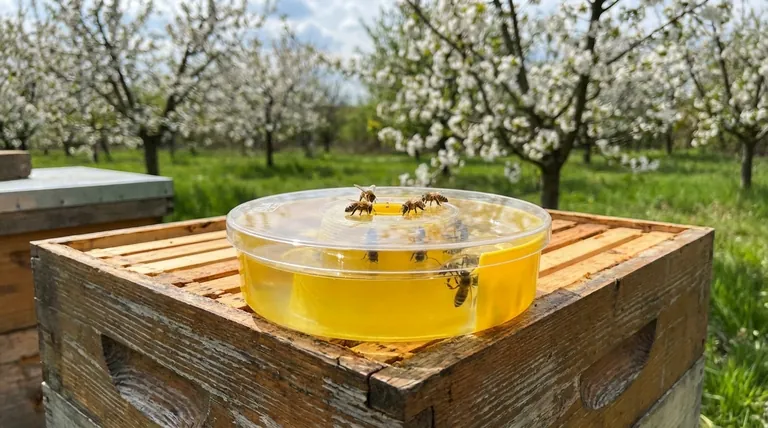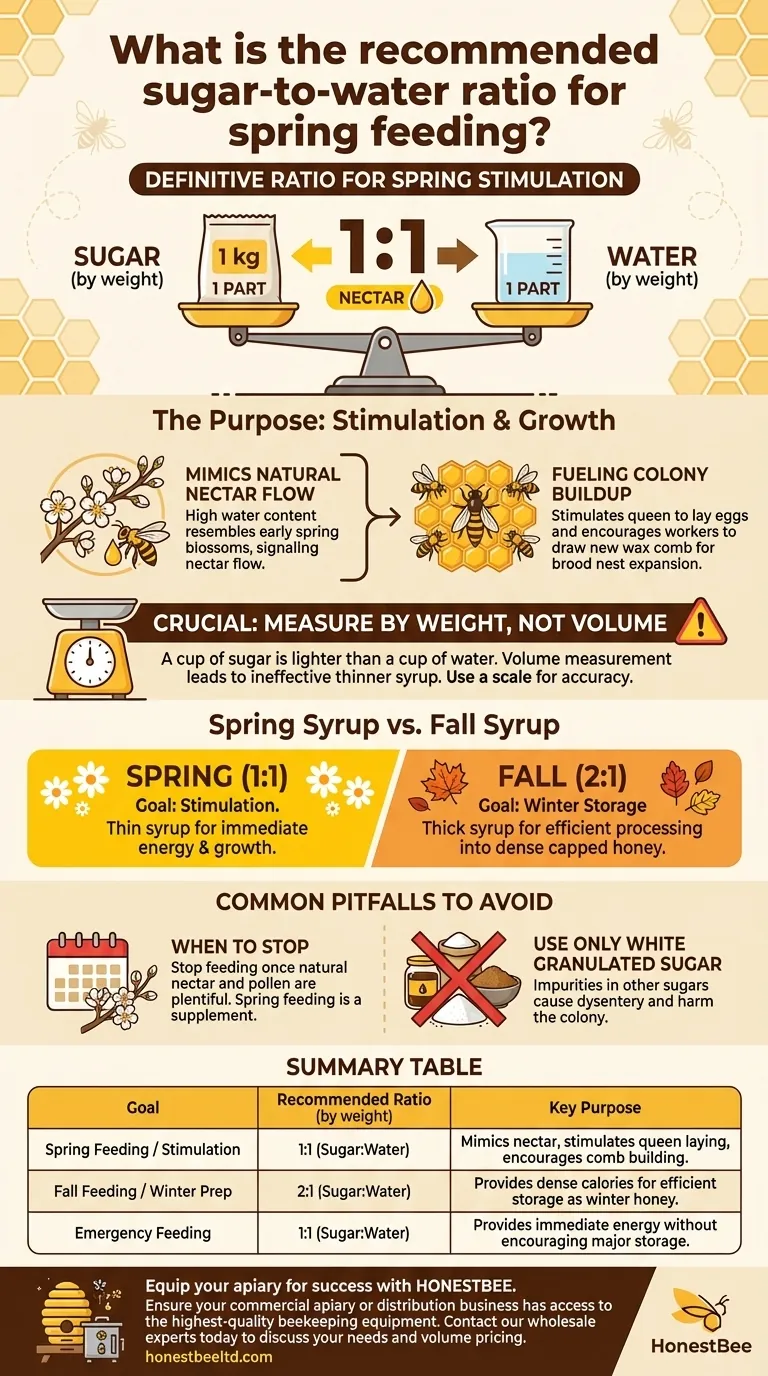For spring feeding, the definitive ratio is one part sugar to one part water (1:1). This mixture is specifically designed to mimic the consistency of natural nectar. Its primary purpose is to stimulate the queen to lay eggs and encourage the colony to build comb, effectively kick-starting its growth after the dormant winter months.
The core principle is that feeding ratios must match the season's goal. A thinner 1:1 syrup in spring provides stimulation for colony growth, while a thicker 2:1 syrup in the fall provides dense calories for efficient winter storage.

The Purpose of Spring Feeding: Stimulation, Not Storage
The goal of feeding in the spring is fundamentally different from feeding at any other time of year. You are not just providing calories; you are sending a specific signal to the colony.
Mimicking Natural Nectar Flow
A 1:1 syrup has a high water content, closely resembling the nectar bees would naturally collect from early spring blossoms.
This consistency signals to the hive that a "nectar flow" has begun. This is a critical trigger for the queen to increase her rate of egg-laying.
Fueling Colony Buildup
The readily available energy from this thin syrup is used for immediate tasks.
It provides the fuel worker bees need for drawing out new wax comb, which is essential for expanding the brood nest to accommodate the queen's increased laying.
Measuring by Weight, Not Volume
It is crucial that the 1:1 ratio is measured by weight (e.g., 1 pound of sugar to 1 pound of water).
A cup of granulated sugar weighs significantly less than a cup of water. Measuring by volume will result in a much thinner syrup that is less beneficial. A simple kitchen scale is the most accurate tool for this.
How Spring Syrup Differs from Fall Syrup
Understanding the contrast with fall feeding clarifies the unique role of the 1:1 spring ratio. The seasonal objective dictates the syrup's consistency.
The Goal of Fall Feeding: Dense Winter Stores
In the fall, the colony's primary objective is to store as much concentrated energy as possible to survive the winter.
Their goal is to create capped honey, which has a very low water content.
The Role of a 2:1 Ratio
A 2:1 syrup (2 parts sugar to 1 part water, by weight) has much less water for the bees to evaporate.
This makes it far more efficient for them to process and cap as winter stores. It saves the colony critical energy as the weather cools and foraging opportunities disappear.
Common Pitfalls to Avoid
Proper feeding supports a colony, but improper feeding can cause harm. Adhering to best practices is essential for hive health.
When to Feed
Spring feeding is a supplement, not a replacement for natural forage. It should only be provided when there are not enough natural nectar sources available.
Once you observe bees actively bringing in plentiful natural nectar and pollen, it is best to stop feeding.
Use Only White Granulated Sugar
You must use only plain white granulated sugar (cane or beet).
Never use brown sugar, molasses, powdered sugar, or raw/organic sugar. These contain solids and impurities that bees cannot digest, which can lead to dysentery and damage the colony's health.
Making the Right Choice for Your Goal
Select your feed ratio based on the specific outcome you want to achieve for your hive.
- If your primary focus is stimulating spring growth: Use a 1:1 sugar-to-water ratio by weight to mimic nectar and encourage the queen to lay.
- If your primary focus is providing emergency food during a mid-season lull: A 1:1 ratio is also appropriate for providing immediate energy without encouraging major storage.
- If your primary focus is preparing the hive for winter: Switch to a thicker 2:1 ratio by weight in the fall to help bees efficiently build their food stores.
Understanding the "why" behind each ratio empowers you to support your colony's natural cycle effectively.
Summary Table:
| Goal | Recommended Ratio (by weight) | Key Purpose |
|---|---|---|
| Spring Feeding / Stimulation | 1:1 (Sugar:Water) | Mimics natural nectar to stimulate the queen to lay eggs and encourage comb building. |
| Fall Feeding / Winter Prep | 2:1 (Sugar:Water) | Provides dense calories for efficient storage as winter honey. |
| Emergency Feeding | 1:1 (Sugar:Water) | Provides immediate energy without encouraging major storage. |
Equip your apiary for success with HONESTBEE.
Proper feeding is just one part of a thriving beekeeping operation. Ensure your commercial apiary or distribution business has access to the highest-quality, durable equipment needed for every season. From feeders and hive tools to protective gear and extraction systems, HONESTBEE supplies the reliable beekeeping supplies that professionals depend on.
Contact our wholesale experts today to discuss your equipment needs and volume pricing. Let us help you build a stronger, more productive operation.
Visual Guide

Related Products
- HONESTBEE Round Hive Top Bee Feeder for Syrup
- Professional Hive Top Bee Feeder for Beekeeping
- Classic Boardman Entrance Bee Feeder Hive Front Feeding Solution
- HONESTBEE Entrance Bee Feeder Professional Hive Nutrition Solution for Beekeeping
- HONESTBEE Professional Entrance Bee Feeder Hive Nutrition Solution
People Also Ask
- Why is a top feeder essential for bees? Ensure Colony Health and Efficiency
- What are the features of top feeders for bees? Maximize Hive Health with Safe, High-Capacity Feeding
- How should syrup for bees be prepared? Master the Ratio for a Thriving Hive
- How do hive top feeders work? A Guide to Efficient, High-Capacity Bee Feeding
- What safety features are included in top feeders? A Guide to Drowning Prevention and Hive Safety



















